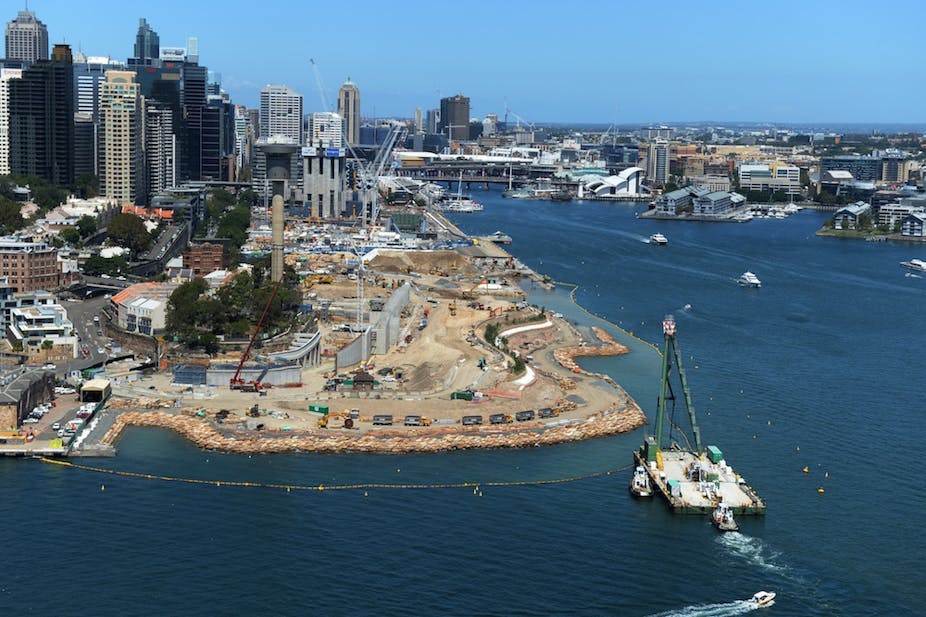Prime Minister Tony Abbott’s planned repeal of 9500 redundant regulations and 1000 Acts of Parliament could loosen dangerously close ties between politicians and developers. While such ties are problematic in many parts of Australia, the recent investigation of the Obeid family by NSW’s Independent Commission Against Corruption has brought this issue to the forefront.
Research that I undertook when I was leading a 2011 bid for a Cooperative Research Centre in Heritage demonstrates that the nexus between politicians and developers in Australia has become perilously close. Over the last decade, red tape involved in the heritage approvals process has resulted in a dramatic increase in direct ministerial approvals for developments.
In New South Wales, for example, the use of ministerial approvals for major projects or infrastructure rocketed from a total of nine during 2001-2005 to 457 in 2010. Forty-three were approved in the two weeks prior to the state government going into caretaker mode.
Red tape is needed to reduce risk and to ensure transparent and equitable processes. However, too much red tape stifles investment. Moreover, frustrated developers seek greater use of ministerial “call in” powers to circumvent slow approvals.
Australia’s current heritage approvals process is fragmented across jurisdictions, between agencies and between Indigenous and non-Indigenous heritage. This has produced mountains of uncoordinated, non-standardised data. This data is inaccessible, often redundant and usually incomplete.
Decision-making power is dispersed across numerous agencies. Decisions depend on the interpretation and knowledge of individuals rather than on a solid evidence base. We need integrated data-sets that make it possible to determine what is common from what is rare or unique. Common approaches to data collection, storage and use should produce consistent decision-making.
The escalation of ministerial approvals for major developments in NSW emerged in 2005. The Environmental Planning & Assessment Act 1979 was amended to include Part 3A for major projects of state and regional significance. Part 3A determined that the only planning approval required was that of the NSW planning minister. Each project had a spend in excess of $50 million.
With Part 3A, both concept and project approval from the minister had statutory force. Part 3A projects circumvented local council approval and both state heritage acts. These projects did not need approvals under either the Heritage Act, 1977 or the National Parks and Wildlife Act, 1974. Moreover, Part 3A projects were protected from emergency protection orders and third party legal challenges under State environmental or planning statutes.
While the aim of Part 3A was to provide up-front certainty for long-term or complex projects, this provision was abused. When the Liberal government came to power in NSW Part 3A was replaced by two separate assessment frameworks. One is for state significant development. The other is for state significant infrastructure. Importantly, the new system constrains the “call-in” powers of the Minister.
It was anticipated that the number of applications designated as state significant would drop by half. Nevertheless, the level of ministerial approvals for major development projects is still way beyond what it was a decade ago.
Throughout Australia fast-tracking major projects through ministerial approval has become a viable alternative to following due process. Occasional exemptions have become routine and the nexus between politicians and developers has grown murkier.
A sustainable alternative to relying on ministerial approvals for large developments is to lessen delays in heritage approvals. Reducing red tape is one part of this.
Developers need access to sound information. A standardised, integrated and coordinated information system would support sound decision-making. A comprehensive database would make it possible to assess if a cultural heritage place is unique, or one of thousands. Such a system would make it possible to classify and rank heritage assets. It would provide an evidence base for determining what can go and what needs protection.
Uncertainty over heritage approvals is costing investment and jobs throughout Australia. In the resource sector, for example, The Fraser Institute’s annual Global Survey of Mining Companies consistently identifies uncertainty over the protection of wilderness, parks and archaeological sites as a strong deterrent to investment across Australia.
There is an economic need for a streamlined information system that reduces the approvals delay and provides certainty for developers. Such certainty needs to be based on good, irrefutable data. In addition, decision-making should be informed by community values in order to pre-empt conflict and provide long-term confidence.
Australia’s cultural heritage is recognised globally as unique. It includes the world’s oldest continuous cultural traditions, some of the first evidence for modern human behaviours and rich rock art complexes. In addition, it includes the histories of more than 200 migrant groups.
This important heritage needs to be protected. However, we need to grow Australia’s economy and we can’t keep everything. Decisions have to be made about what we pass on to the next generation as heritage and what we let go. These decisions need to be transparent, fair and consistent.
Reliance on ministerial approvals raises concerns about transparency and challenges the integrity of the system. It is possible that the current corruption cases in NSW are only the tip of the iceberg.

